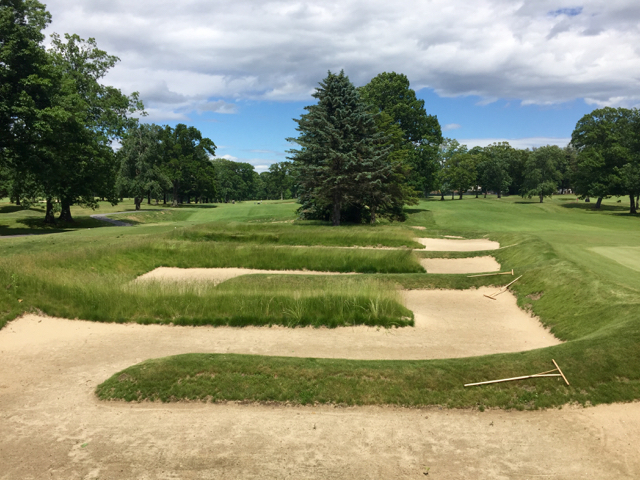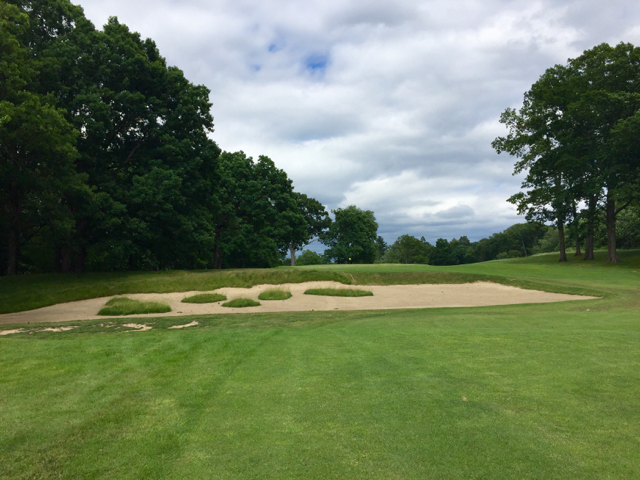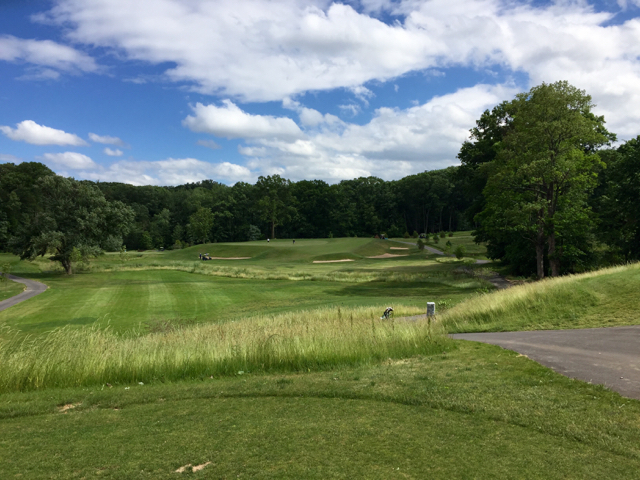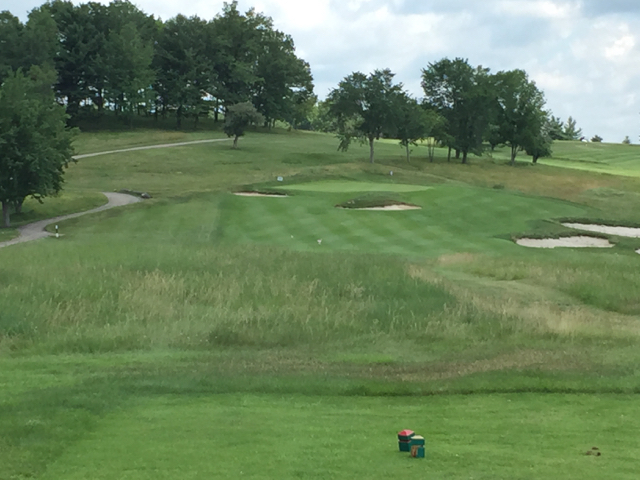Last week I read yet another poorly researched and stupid article by a real estate writer predicting the doom of golf communities. He used, as evidence, one golf community owner in Arizona who wants to plow over his golf course and build more homes. Nowhere in the perfunctory article is there any discussion about extenuating circumstances or whether the golf course was managed properly or poorly.
Lost also in the media’s fascination with the alleged death of golf are the stories of long-established golf courses that have undergone significant restoration and renovations -– which brings us to Keney Park, located at the extreme north end of Hartford, CT. The park itself opened in the late 19th Century when the city was arguably the wealthiest in America, thanks largely to being the insurance center of the nation.  The church pew bunkers beside the 8th green at Keney Park and adjacent to the 7th tee box are reminiscent of the more famous set at Pittsburgh's Oakmont Country Club.
The church pew bunkers beside the 8th green at Keney Park and adjacent to the 7th tee box are reminiscent of the more famous set at Pittsburgh's Oakmont Country Club.
Keney Park Photos by Tim Gavrich
The park’s golf course, like Keney itself, has great historical value. Devereux Emmet laid out the first nine holes, which opened in 1927, and the second nine were added by a member of the city of Hartford's engineering department in the early stages of the Great Depression in 1930. (The engineer, Jack Ross, also designed the other city course in Goodwin Park.) Ironically, the Depression spurred the construction of the brick clubhouse that was finished as a national public works project in 1934. (It is currently being restored and should be ready for use next spring.) Emmet, who designed more than 150 golf courses worldwide, maintains a strong reputation in golf architecture circles, and is responsible for the layouts at Congressional Country Club outside Washington, D.C., and Leatherstocking Golf Club in Cooperstown, NY. The designer was especially prolific in the Hartford area and is credited with 18 of Hartford Golf Club’s 27 holes and the layouts at Country Club of Farmington and Manchester Country Club. One of my favorite classic courses, Copake Country Club, just over the Connecticut border in New York State, is an Emmet design.
Keney began as a private park on farmland owned by a never-married wealthy local businessman, Henry Keney, whose cousin encouraged him to leave his name on something that would endure. His will provided not only the land but also funds for the park, laid out and landscaped in the 1890s by the famous Frederick Law Olmstead’s company. (Olmstead was a Hartford native.) The park and the golf course were immensely popular, first with wealthy north Hartford residents in the early 20th Century and later by a more diverse population of mostly Jewish and African-Americans. In later years, many of the area’s white residents left for the suburbs; most of Keney’s neighbors today are persons of color, many of them immigrants. The play on the par 5 10th hole at Keney Park is to lay up just short of the fairway bunker 130 yards from the green, and take your chances that you will be able to hit past the green's false front.
The play on the par 5 10th hole at Keney Park is to lay up just short of the fairway bunker 130 yards from the green, and take your chances that you will be able to hit past the green's false front.
In the 1970s, Keney Park fell into disuse despite its pedigree and beautiful grounds, as Hartford itself became one of the poorer cities in the nation. The park’s secluded areas, once considered a lure for visitors, scared many people away because of the possibility of criminal activity. The area’s residents, with the strong support of Hartford’s police department, rallied to Keney’s defense, and by the mid 1990s, things were looking up for the park. Nevertheless, conditions on Keney’s golf course had deteriorated after the turn of this century, and the nail in the coffin was the hiring of a company whose management of the club, if not criminal as some alleged, was certainly inept at best. Trees and fallen limbs littered the golf course, and the old line about a “cow pasture” would not have been an inappropriate description of the fairways and greens.
Thankfully, city officials were shocked enough at the conditions to fire the management company in charge of the club and authorize the $5.8 million needed to restore the golf course to Emmet’s original specifications. Construction began in 2013 under the guidance of a firm headed by Ken Dusenberry and with input from Brad Klein, the golf architecture critic for Golfweek magazine, and the course reopened in April this year, albeit with the pro shop located in a trailer and no potable water available on the golf course. (A local catering company offers food and drink from a food truck parked near the clubhouse.) Golfers won’t care about the temporary lack of amenities; I have now played the course twice this year with friends, and all of us believe it to be the equal of most private courses in the area and as good as any public layout in the state.
Yesterday, my friend Bill and I played at Keney and he pronounced the greens as good as those at his private course in Simsbury, CT, Hop Meadow Country Club, one of the best layouts in the northern half of the state. (I was a member there for 25 years.) I don’t recall playing a public course’s greens that were any faster than Keney’s, perhaps a consequence of the state PGA Championship having used the course the two previous days. Although the course ratings and slopes at Keney are rather timid –- just 70.6 and 127 from the back tees at just 6,449 yards –- it played much tougher with those fast and firm greens. Further, some of the greens feature huge sloping areas, most notably at the par 4 7th hole, called “Biarritz,” where the pin was on the top level. (Biarritz is a design element that features two dramatically different levels on a green bisected by a gully that runs its entire width.) The par 3 13th hole at Keney Park is 188 yards long from the tips, with trouble to the left and behind the elevated green.
The par 3 13th hole at Keney Park is 188 yards long from the tips, with trouble to the left and behind the elevated green.
Emmet seems to have channeled other iconic elements of golf architecture, including a church pews grouping of bunkers beside the par 4 8th hole, called Hogs Back, which are certainly reminiscent of the more famous pews at Oakmont. Other bunkering is equally dramatic, as on the par 5 10th hole, where a second shot must either be busted over an almost fairway wide bunker containing a few menacing grass buttons, or played short of the bunker, leaving a 130 yard uphill approach to the forward tilting green. Strategic thinking abounds across the entire 18 holes at Keney Park, although I found the par 3s, with one exception, a little less intimidating than the longer holes. Yet, on the downhill, 127-yard aptly named “Short” hole, a huge swale front and center on the green shielded the bottom two thirds of the pin from view, and it wasn’t until we reached the green that we found out where our shots had ended up; a shot landing at the back edge of the swale could easily have bounded off the back of the green. (Thankfully, we both were within 20 feet and made par.)
Bill and I agreed there was only one "odd" hole, the par 5 2nd. It played to 491 yards from our Blue tees, but moderately long hitters will leave driver in their bags and opt for a 5-wood or long iron to stay short of a stream that bisects the fairway. Fans of par 5s of less than 500 yards will be disappointed in a lay up drive that will leave little chance of chipping or putting for eagle. That hole, and a few off-fairway areas that are sparsely grassed, are minor quibbles with a golf course that is about as much fun to play as any in the northeast. And green fees are a bargain, especially if you are a Hartford resident ($27 weekday, $28 weekend) or a non-resident “senior” ($27/$38; the course’s website doesn’t specify what age constitutes senior but I did not get carded). Non-residents of a younger age pay just $37 on weekdays, $38 on the weekend. The course is easily walked if you want to skip the modest cart fees and get some exercise.
Those serious golfers with business in the Hartford area might consider bringing their clubs along, as Keney Park is a mere 17 minutes from Bradley International Airport. Those who already live in the Hartford area are especially lucky and should beat a path through the woods to Keney Park before the trees drop their leaves. Keney Park's designer, Devereaux Emmet, also designed Copake Country Club, just over the Connecticut line in New York State.
Keney Park's designer, Devereaux Emmet, also designed Copake Country Club, just over the Connecticut line in New York State.



